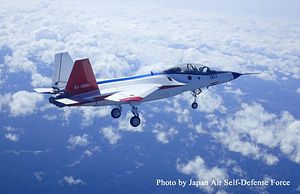Japan wants to deploy a new fifth-generation air superiority fighter by the 2030s and is in the process of launching a tender for a fighter jet contract estimated to be worth $40 billion as early as this month sources within Japan’s Ministry of Defense (MOD) told Reuters.
A ministry spokesperson said that Japan will reach out to foreign military contractors in the weeks ahead after a July 5 deadline for expression of interest in the tender expired. The defense ministry is expected to award a contract in the summer of 2018. Up to a 100 new aircraft could be inducted into the Japan Air Self-Defense Force (JASDF) by the 2030s.
The JASDF has three options, according to a Japanese official interviewed by Flight Global. First, develop an indigenous air superiority fighter. Second, partner with a foreign defense contractor and license-produce a new aircraft. Third, import or upgrade an existing platform.
“General discussions are underway,” according to the official. As I reported previously (See: “Japan’s New Stealth Fighter Jet to Conduct 50 Flight Tests in 2016-17”), Japan’s Acquisition, Technology & Logistics Agency (ATLA), which is part of the MoD, has unveiled an experimental fifth-generation fighter technology demonstrator, dubbed X-2 “Shinshin” (formerly the ATD-X), and developed by Mitsubishi Heavy Industries with more than 200 Japanese firms participating in the program in some capacity, in January.
Japan will decide within the next two years whether to move forward with the X-2 and use the prototype as the basis for the so-called (F-3) Future Fighter Program. So far Tokyo has spent 39.4 billion yen ($332 million) on the development of the technology demonstrator.
U.S. defense contractor Lockheed-Martin is supposedly involved in an unknown capacity in the development of the X-2 aircraft and it also seems likely that should Japan decide to partner with a foreign vendor, a U.S. aircraft maker will be the first choice.
“Japan is seeking information from a variety of potential industry partners and we are certainly interested in another potential opportunity to bolster our longstanding partnership with Japan,” Lockheed Martin said in an email to Flight Global.
“We are proud of our successful partnerships with Japan on the F-35 program and Mitsubishi Heavy Industries on the F-2 program. We look forward to learning more about Japan’s F-3 plans as discussions progress.”
Lockheed Martin was denied an export license to sell its F-22 Raptor stealth air superiority fighter to Japan in the 2000s. As a result, Japan’s defense industry initiated the X-2 program in order to design a fifth-generation twin-engine stealth aircraft with long-range capability and an internal weapons bay.
As an interim solution, Japan decided to acquire 42 Lockheed Martin F-35 Lightning II Joint Strike Fighters, the first of which are slated for induction into the JASDF at the end of 2016. However, export restrictions continue apply, and despite the aircraft being license-produced by Mitsubishi in Japan, it will not have access to some of the aircraft’s most sensitive technologies.
“With the F-35 program we are not allowed access to the highest technologies that the U.S. has,” Hirofumi Doi, the manager of the Future Fighter Program at ATLA said in May. The U.S. aircraft maker Boeing has also expressed interest in the tender along with the Eurofighter consortium and Sweden’s SAAB.

































